Intervertebral Disk Disease, or IVDD for short, is a degenerative disease of the spinal cord in dogs. Also known as a “hernia” (what my vet called it in Germany), symptoms range from mild pain to complete paralysis of the back legs, with severe cases best treated by surgery.
The disease occurs most commonly in Dachshunds, due to their short legs and long spine, with up to 1 in 4 Dachshunds expected to come down with it, generally between the ages of 4 to 8.
As the owner of a Miniature Dachshund, I knew that there was a risk my dog could be affected. So, what happened when my Dachshund, Schnitzel, came down with IVDD while we were travelling in 2017?
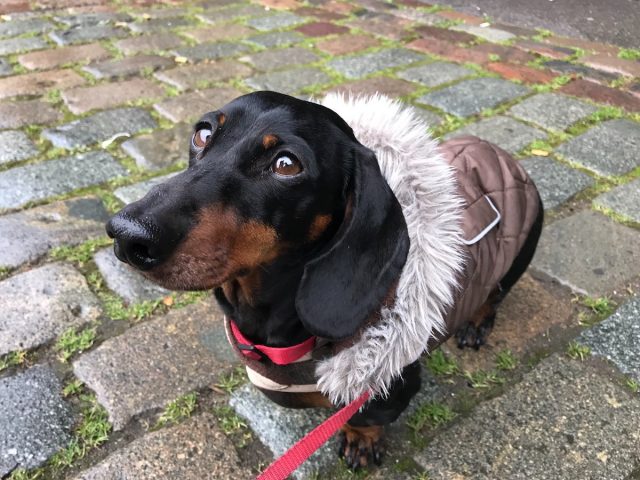
Thoughts on IVDD When Setting Off on Our Travels
After becoming aware of this issue before getting our Miniature Dachshund, Schnitzel, we put in place measures to decrease the likelihood of him succumbing to it.
Before our travels, we had a house on a single floor (with no internal stairs and only a couple of steps at the front), always carried him up and down stairs, and tried to stop him jumping on and off furniture. Additionally, we were strict with his diet, to make sure he didn’t get overweight.
When heading off on our travels with Schnitzel in 2017, I was aware that as he was then 4 years old, during our travels he would be at the age that Dachshunds most commonly come down with an episode of IVDD. He’d always been a healthy dog, with minimal vet visits, except for one slight case of pancreatitis, so hopefully that would continue.
However, while travelling and spending a lot of time walking, it would be harder to prevent him from going up and down stairs and jumping off things, compared to when we lived in our previous house.
A Night at the Christmas Market in Ulm
After we’d been on the road for 10 months, we visited the city of Ulm in the south of Germany. We spent the day visiting a UNESCO World Heritage listed prehistoric rock art site (part of our journey to visit every World Heritage site in the world), walking across snow-covered paths to view the entrance of a cave. We then visiting a museum in the nearby town, Schnitzel sitting on my husband’s or my own lap while we took turns inside.
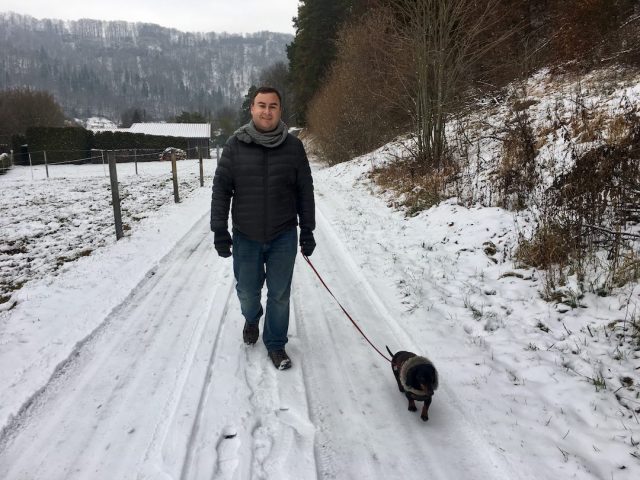
We took the train back to Ulm, then headed to the popular Christmas Market in the main square to have some some German sausages for dinner and check out the displays again. As it was a bit crowded, we carried Schnitzel around, and didn’t put him down until we had left the market and were walking back to our hotel.
After walking a few steps, we noticed that Schnitzel was in pain, and was arching his back, something he’d never done before. We immediately suspected IVDD, and carried him back to our hotel, before putting him in his bed and researching the symptoms online.
Schnitzel was still able to walk, but was obviously in pain and his back legs weren’t that steady. Reviewing details of the symptoms online, we suspected he had stage I or II IVDD.
Stage I generally exhibits pain only, while Stage II involves weak and wobbly back legs. The most severe cases are Stage V, complete paralysis of the back legs, with surgery usually being recommended for Stage III-V IVDD.
Visiting the Vet in Nuremberg
By a crazy coincidence, we had booked Schnitzel into the vet in Nuremberg, where we were next headed in Germany, the very next afternoon. He was due to have his annual vaccines and we also wanted him to have a rabies booster, both so it was recorded in his EU Pet Passport after his microchip reading date and because some countries only recognise the 1-year not the 3-year rabies vaccine.
That night and the next day on the train ride, Schnitzel continued to show pain and not want to walk. We didn’t let him stand up or walk around, except to do his business outside. Our normally happy Dachshund was feeling quite sorry for himself. Luckily though, his symptoms did not worsen.

We had selected the vet in Nuremberg based on online recommendations of veterinary clinics with English-speaking vets. When making the appointment via email, I had requested a vet that could speak some English, though I knew a little German too. But it’s a lot simpler to request vaccines than discuss IVDD!
Upon arriving at the vet, we immediately brought up Schnitzel’s pain and that we thought it was IVDD (or as the German vet called it, a “hernia”). She felt his spine and tested his responses, including by trying to fold his paws back. (A well dog shouldn’t allow this or should immediately fix their position. Schnitzel barely moved his paws.) He definitely was suffering from IVDD.
Schnitzel’s vaccines were postponed until later, as it wasn’t possible to have them and give him the pain medication. The topic of surgery wasn’t broached, either because his level of IVDD was less severe, or potentially because conservative treatment (without surgery) may be more common in Germany.
Schnitzel was instead given pain medication, including an immediate injection, and we were left with instructions to not let him walk and another appointment in a week’s time.
Dealing with Pet Issues In a Non-English Speaking Country
Despite the vet speaking some English, and myself a little German, it was difficult to have an in-depth discussions about IVDD. Compared to if I visited a vet at home in Australia or another English-speaking country, it was difficult to ask more than basic questions.
Luckily, I was already fairly aware of IVDD, plus had read up a lot the previous evening, before the vet appointment. Despite the usual warnings about turning to “Dr Google”, in a situation like this it’s best for you to read up as much as possible online, rather than relying on the vet providing you with the full information.
If you do find yourself in a similar situation, I recommend these two websites:
- Dachshund IVDD Support Australia (or DISA for short)
- Dachshund IVDD (Dachshund Health UK)
Additionally, I joined a Facebook group run by Dachshund IVDD Support Australia, specifically created for Australian owners of Dachshunds who have experienced IVDD.
First Week after the IVDD Episode
I’ll firstly note that we were very lucky, that Schnitzel’s IVDD episode never become more severe, so surgery wasn’t something that we needed to consider. If that had been the case, we would have had to have it in Germany or somewhere else in Europe.
Considering the preparation for his return to Australia takes at least 6 weeks, plus he would require a health certificate stating he was okay to fly, returning to Australia immediately was out of the question.
For the next week, over Christmas, we had pre-booked an Airbnb in Nuremberg for the week. We had originally planned to do various day trips, but we cancelled all our plans and spent most of the week in the apartment, only one of us going out at a time, if at all.
Back in Australia we had a crate, that Schnitzel loved to sleep in. Ideally we would have used it for his crate rest. Due to the size and weight of a crate, combined with currently using a train to get around, we skipped buying one now. Instead he was strictly kept in his bed, on the floor.
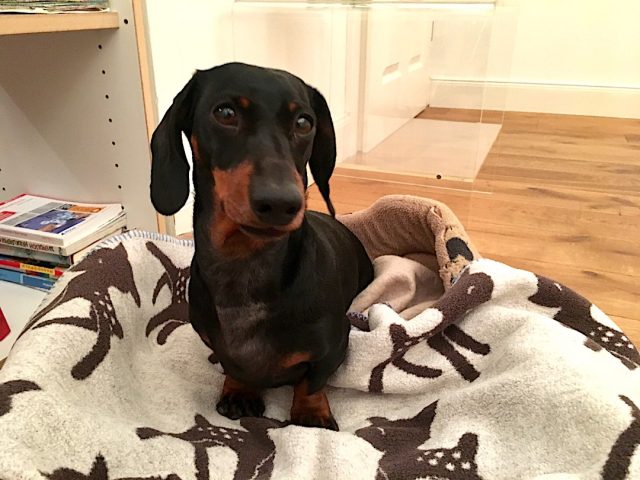
For the first few days, while he was still experiencing pain, that was easy, as he didn’t want to walk around. But towards the end of the week, we needed to keep a closer eye on him, and he was told off if he tried to leave his bed. Piling up some things next to his bed helped to keep him in it.
At the end of the week, just before leaving Nuremberg, we returned to the vet. By now, Schnitzel had been pain-free for half a week. His back right leg seemed fine, although his back left leg still wasn’t fully recovered, but was close. The vet was happy with his progress and gave him the vaccinations that had previously been postponed.
Treating IVDD While Travelling
We then took the train we had booked to Munich, where we had originally made plans to just chill for a week, with virtually nothing planned. This suited Schnitzel’s recovery fine, although I was personally starting to get a bit of cabin fever!
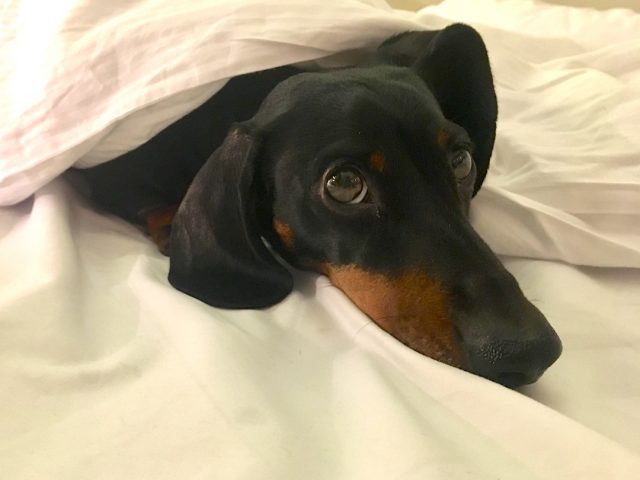
By now Schnitzel was wanting to walk around, rather than stay in his bed. It took some discipline to keep him in his bed most the time, and not allow him to walk too much (or even run, at times!) Our hotel room with a kitchenette was a decent size for a hotel room, but the limited floor space compared to a normal house helped.
By the end of this second week of strict rest, Schnitzel seemed completely fine, although we knew we should continue to rest him.
After our stay in Munich, we did however return to our original itinerary, taking a train on to Italy and slowly travelling through the north of Italy for four weeks. The major change we did make for those four weeks was that we mainly carried Schnitzel while out sightseeing. Our aim was to give him the full six weeks rest that had been recommended. Luckily he’s a small mini and only 5kg!
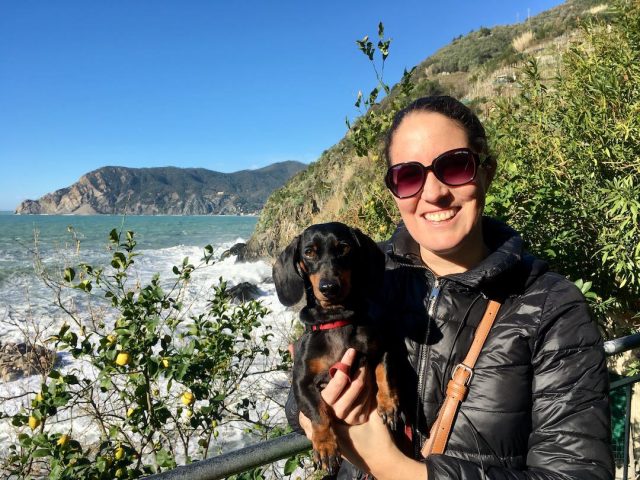
Also, when we had a hire car, we did leave him in the car at times. The cool, but not too cold, temperatures meant that he was quite happy snuggling under his blanket in his bed on the back seat, his seat belt attachment stopping him from leaving his bed.
I know that the general rule these days is not to leave dogs in cars, but we only did it when we knew he was be comfortable and not at risk of getting hot. We were also reluctant to leave him alone in our Airbnb apartments, as we couldn’t stop him walking (or running) around.
Travelling After An IVDD Episode
At the six week anniversary of Schnitzel coming down with IVDD, he was doing very well. He was walking (and running) completely fine, and had had no signs of another episode. Not that it meant we stopped worrying about the chance of another episode.
We started to regularly let him walk around when we were sightseeing, although we no longer let him walk all day, if we were spending the day on our feet. We made sure he had breaks, carrying him at times to give him a rest. (His steps are a lot shorter than human steps, so it’s crazy to think how many steps he does in a day when we get up to 20,000 steps, not that he’s ever been less than eager!)
We were extra strict with not letting him walk up or down stairs, when out and about, plus with not letting him jump off furniture, though of course has still did it occasionally (and was scolded!)
Our plan was to continue travelling for the rest of the year with Schnitzel, arriving back in Australia in December. And perhaps due to our crossed fingers, he was fine for the rest of the year, and didn’t come down with another IVDD episode while we were travelling around Europe, not until many years later…
You May Also Like
About the Author
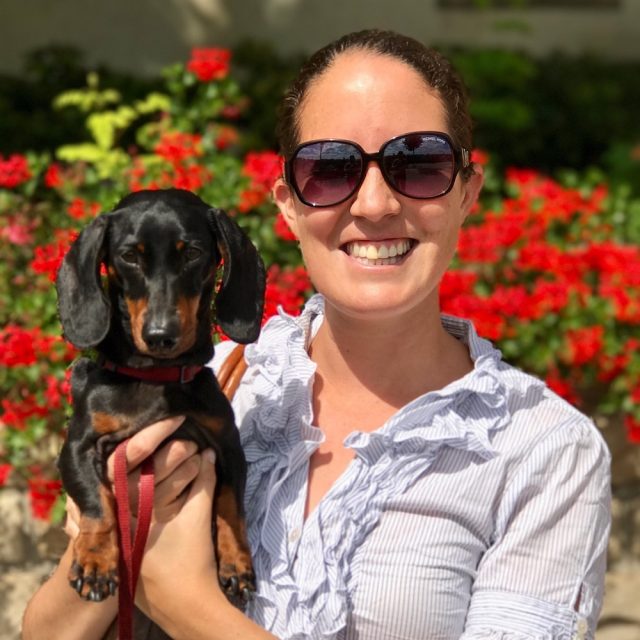
Shandos Cleaver is the founder of Travelnuity: Dog-Friendly Travel. She has travelled extensively with her Miniature Dachshund, Schnitzel, including to 33 countries across Europe, every state and territory of Australia except Tasmania, and 10 of the United States. She’s passionate about providing inspiration and information to others wanting to travel with their dogs, whether close to home or internationally.
Pin this to your Pinterest board!
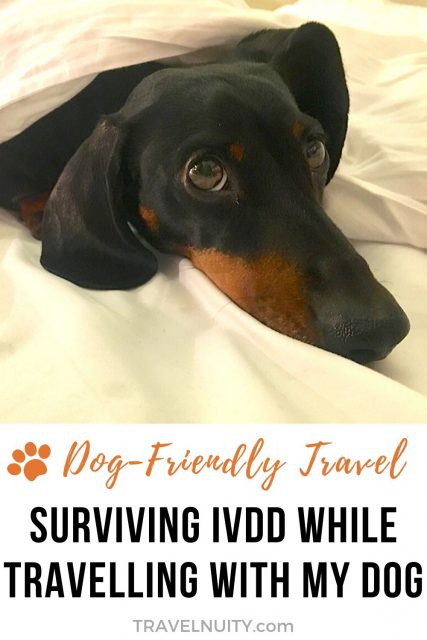

OMG poor baby, he’s looking so sorry for himself in some of those snaps! Glad to hear he is on the mend. Hope to see you soon, Schnitzel baby!
Thanks for your kind wishes, Amy! He certainly was not himself for awhile, but you should see him run around now!
I love all your writing , Traveling and your Family with Schnitzel .. I know he will be better with all the care and love you give him
Thanks so much Malu!
Hi Shandos! Thanks for sharing your IVDD experience with Schnitzel! How’s he doing these days? We have a 5 yo mini doxie ourselves and have been planning to take him with us to Europe for a month. He recently had a mild episode of IVDD. It’s a new diagnosis, so we are debating the wisdom of taking him with us after all. We’re quite active but we’ve been planning a semi-active trip in consideration of our doxie joining us.
After his IVDD, how much distance could Schnitzel cover comfortably before taking breaks? And is there a carrier that you used for carrying him during hiking that you’d recommend? Any other insights on traveling with a dog w IVDD?
Anne – I would make sure he’s thoroughly recovered before taking him travelling, with at least 6 weeks of rest or whatever your vet recommends. While our dog was meant to be resting and we were travelling, we literally carried him everywhere. We probably should have bought him a carrier, but we never found one that was quite right for his long length.
After his episode, we were a lot more cautious about pushing him or taking him on long walks. While previously we took him on walks of up to 10km, these days the longest walk is only a couple of kilometres, or wandering around with us for the day (and carrying him if he seems reluctant to walk). He unfortunately had another episode last year, that required surgery. Once again he has recovered well, but we still worry.
We’ve decided against taking him with us, after all. His comfort and safety are the utmost priority so we’ve decided he’s better off staying home. I’m sorry to hear that Schnitzel had another episode, but happy that he is recovered from it. Once again, thanks for sharing your experience! Cheers to you and Schnitzel!
Thanks. I hope your dog also make a full recovery and you can travel together again the future xx